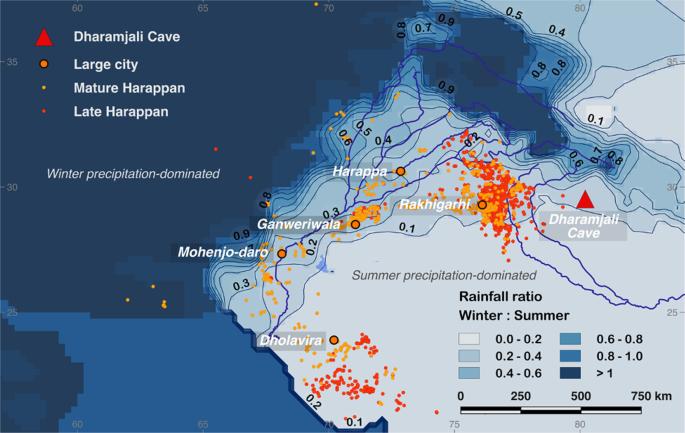Recurring summer and winter droughts from 4.2-3.97 thousand years ago in north India
IF 8.1
1区 地球科学
Q1 ENVIRONMENTAL SCIENCES
引用次数: 3
Abstract
The 4.2-kiloyear event has been described as a global megadrought that transformed multiple Bronze Age complex societies, including the Indus Civilization, located in a sensitive transition zone with a bimodal (summer and winter) rainfall regime. Here we reconstruct changes in summer and winter rainfall from trace elements and oxygen, carbon, and calcium isotopes of a speleothem from Dharamjali Cave in the Himalaya spanning 4.2–3.1 thousand years ago. We find a 230-year period of increased summer and winter drought frequency between 4.2 and 3.97 thousand years ago, with multi-decadal aridity events centered on 4.19, 4.11, and 4.02 thousand years ago. The sub-annually resolved record puts seasonal variability on a human decision-making timescale, and shows that repeated intensely dry periods spanned multiple generations. The record highlights the deficits in winter and summer rainfall during the urban phase of the Indus Civilization, which prompted adaptation through flexible, self-reliant, and drought-resistant agricultural strategies. Seasonally resolved speleothem isotope and trace element records from Dharamjali Cave in the central Lower Himalaya show an increased frequency of summer and winter droughts during the period between 4.2 to 3.97 thousand years ago.

4.2-3.97万年前印度北部反复发生的夏季和冬季干旱
4.2 千年一遇的干旱被描述为一场全球性的特大干旱,它改变了包括印度河文明在内的多个青铜时代的复杂社会,印度河文明位于一个具有双峰(夏季和冬季)降雨系统的敏感过渡区。在这里,我们从喜马拉雅山脉达兰贾利洞穴的痕量元素以及氧、碳和钙同位素中重建了夏季和冬季降雨量的变化,时间跨度为距今 4.2-3.1 千年。我们发现,在距今 4.2 至 3.97 万年前的 230 年间,夏季和冬季干旱的频率不断增加,在距今 4.19、4.11 和 4.02 万年前出现了多年代干旱事件。亚年分辨率的记录将季节变异性置于人类决策的时间尺度上,并显示出反复出现的严重干旱期跨越了多个世代。该记录突显了印度河文明城市阶段冬季和夏季降雨量的不足,这促使人们通过灵活、自力更生和抗旱的农业策略来适应。喜马拉雅山下中部达兰贾利洞穴的季节性分辨岩浆同位素和微量元素记录显示,在距今420万年至397万年期间,夏季和冬季干旱的频率增加。
本文章由计算机程序翻译,如有差异,请以英文原文为准。
求助全文
约1分钟内获得全文
求助全文
来源期刊

Communications Earth & Environment
Earth and Planetary Sciences-General Earth and Planetary Sciences
CiteScore
8.60
自引率
2.50%
发文量
269
审稿时长
26 weeks
期刊介绍:
Communications Earth & Environment is an open access journal from Nature Portfolio publishing high-quality research, reviews and commentary in all areas of the Earth, environmental and planetary sciences. Research papers published by the journal represent significant advances that bring new insight to a specialized area in Earth science, planetary science or environmental science.
Communications Earth & Environment has a 2-year impact factor of 7.9 (2022 Journal Citation Reports®). Articles published in the journal in 2022 were downloaded 1,412,858 times. Median time from submission to the first editorial decision is 8 days.
 求助内容:
求助内容: 应助结果提醒方式:
应助结果提醒方式:


